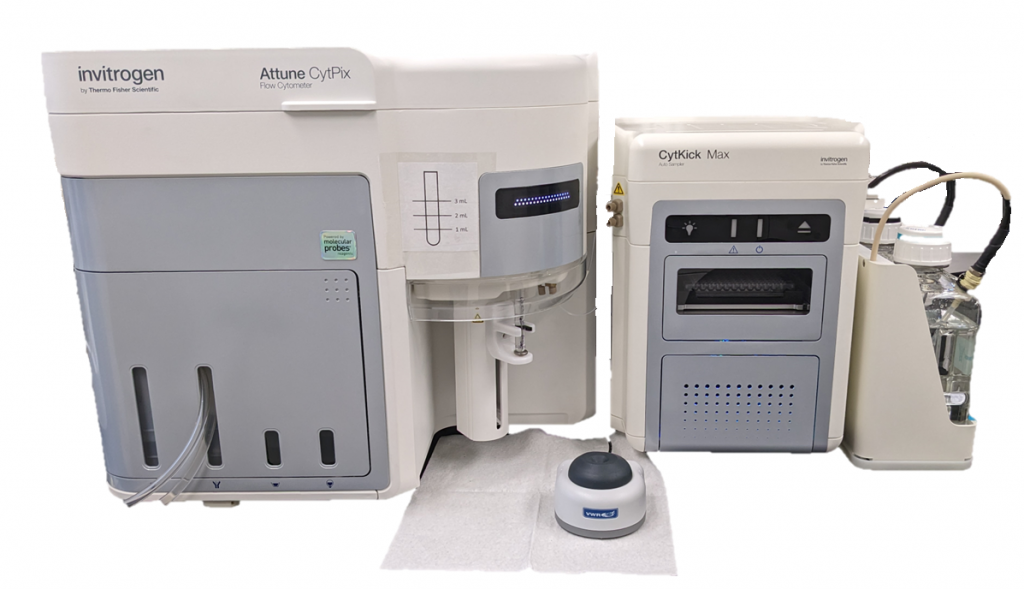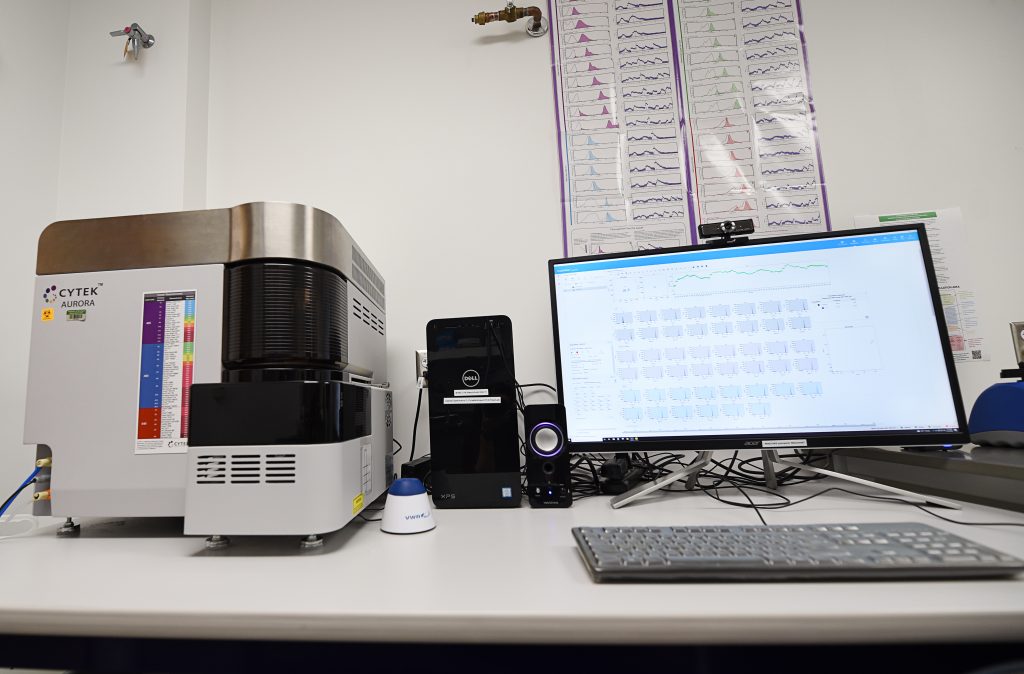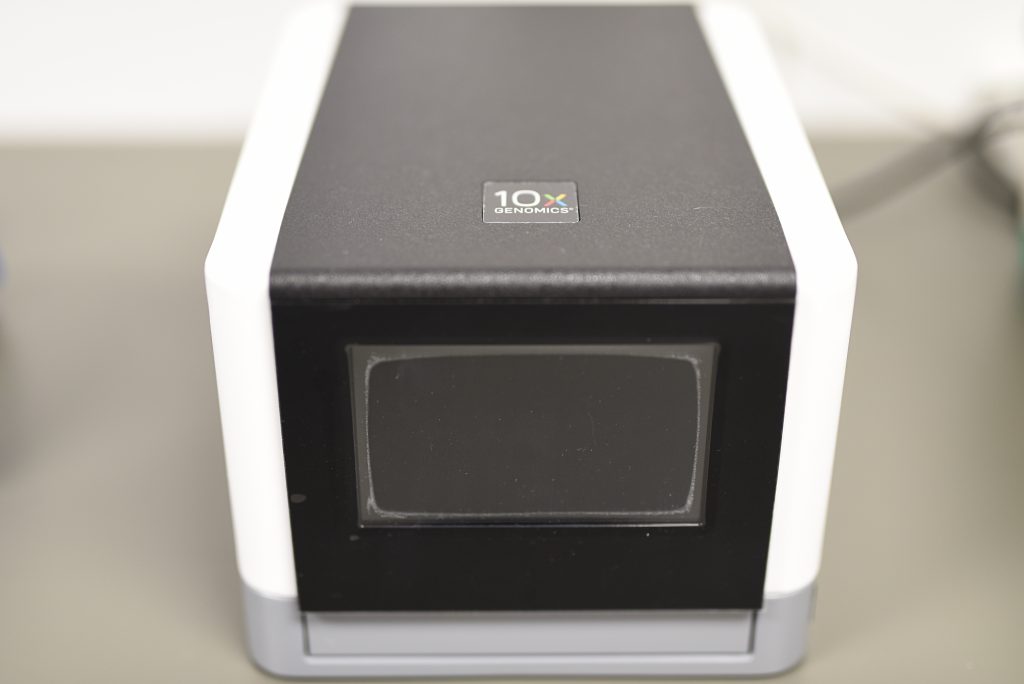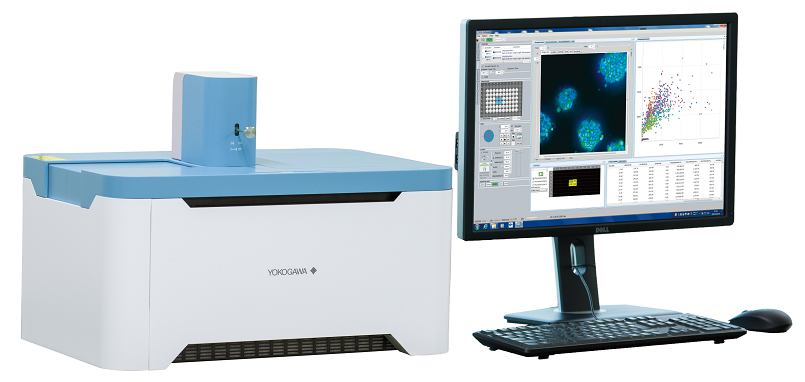Instrumentation
Benchtop Analyzers
ThermoFisher Attune Cytpix
Analyzer – BPS 4120
Unassisted use $31/hr

For more details on the optical configuration of this instrument and the available filter sets, see the following link: Attune CytPix
To help plan your panel, use the following links to check your fluorophores using the current optical configuration of the Attune CytPix
Spectra Viewer: 405nm, 488nm, 561nm, 637nm
Suggested verbiage for Acknowledgements:
The Attune CytPix, located in the MSU Flow Cytometry Core Facility, is supported by the Equipment Grants Program, award #2022-70410-38419, from the U.S. Department of Agriculture (USDA), National Institute of Food and Agriculture (NIFA).
The Attune CytPix is a high-throughput imaging cytometer (22 minutes to run a full 96-well plate) equipped with acoustic focusing, a high-speed brightfield camera, and CytKick Max autosampler. Key features include:
- Supports: 96-well, 384-well, microfuges tubes, and custom plate types
- Syringe based fluidics: accurate volumetric measurements, absolute counts, returns unused sample
The Attune Cytpix contains 4 lasers and can detect up to 14 fluorescent parameters and 2 light scatter parameters using the following emission filters:
- 405nm (Violet):
- VL1 (450/50) – AF405, Pacific Blue, BV421
- VL2 (525/50) – BV510, CFP, eFluor 506
- VL3 (610/20) – BV605, Zombie Yellow
- VL4 (660/20) – BV650, SuperBright 645
- VL5 (710/50) – BV711, SuperBright 702
- VL6 (780/60) – BV786
- 488nm (Blue):
- BL1 (530/30) – GFP, AF488, FITC
- BL2 (695/40) – PerCp, PE-AF700
- 561nm (Yellow-Green):
- YL1 (585/16) – PE, PI, AF568
- YL2 (620/15) – mCherry, AF594
- YL3 (780/60) – PE-Cy7, Qdot800
- 637nm (Red):
- RL1 (670/14) – APC, AF647, Helix NP NIR
- RL2 (720/30) – AF700, Qdot 700
- RL3 (780/60) – Fixable NIR, APC-Cy7
Cytek Aurora
Analyzer – IQ 2521
Unassisted use $52/hr

For more details on this instrument, see the following link: Cytek Aurora
The Cytek Aurora is a spectral flow cytometer with state-of-the-art optics and low-noise electronics which provide excellent sensitivity and resolution. The instrument is also equipped with a 96-well plate auto-sampler for high-throughput sample acquisition.
The Cytek Aurora is equipped with the following 5 lasers and has the capability of detecting up to 64 fluorescence channels with additional light scatter detectors off of the violet (SSC) and blue lasers (FSC and SSC).
- 355nm (UV)
- 405nm (Violet)
- 488nm (Blue)
- 561nm (Yellow-Green)
- 640nm (Red)
Cell Sorters
SONY MA900
Sorter – BPS 5115
Assisted/Unassisted Sorting $128/hr

For more details on the optical configuration of this instrument and the available filter sets, see the following link:
Optical Configuration
Spectral Viewer: 488nm|561nm 405nm | 638nm
Sorting Best Practices
The SONY MA900 is a unique instrument that provides unparalleled workflow automation, a modular fluidics system, and advanced biosafety features, making it the perfect instrument for independent use in Core facilities. The instrument is capable of high-speed sorting, up to four populations simultaneously into tubes (12x75mm or microfuge tubes) or a plate deposition system (6-well through 384-well plates). The MA900 is fitted with 70, 100, and 130 μm nozzles to allow sorting for a wide variety of cell types. Contained with a Baker Biosafety Cabinet, the MA900 can accommodate up to BSL-2 samples.
The MA900 contains 4 lasers in co-linear pairs (488nm & 561nm, and, 405nm and 634nm) and can detect up to 12 fluorescent parameters and 2 light scatter parameters using the following emission filters:
- 488nm | 561nm (Blue|YellowGreen):
- FL1 (525/50) – GFP, AF488, FITC
- FL2 (585/30) – PE, tdTomato
- FL3 (617/30) – mCherry, PI
- FL4 (695/50) – mPlum, 7-AAD, PE-Cy5
- FL5 (785/60) – PE-Cy7
- 405nm | 638nm (Violet|Red):
- FL6 (450/50) – DAPI, AF405, BV421
- FL7 (525/50) – AmCyan, BV510
- FL8 (585/30) – BV570
- FL9 (617/30) – BV605
- FL10 (665/30) – BV650, APC, AF647
- FL11 (720/60) – BV711, AF700
- FL12 (785/60) – BV785, APC-Cy7
BD FACS Aria IIu
Sorter – IQ 2522
Assisted Sorting $144/hr

For more details on the optical configuration of this instrument and the available filter sets, see the following link: BD FACSAria Ilu
Sorting Best Practices
The BD FACSAria IIu is the original model FACSAria-I cell sorter that has been upgraded with a FACSAria II flow cell and fluidics. The instrument is capable of high-speed sorting (50×106 cells/hour depending on cell type) up to four populations simultaneously into Eppendorf tubes, 5 mL, or 15 mL conical tubes, and multi-well plates (up to 96-well). The FACSAria is fitted with 70, 85, and 100 μm nozzles to allow sorting for a wide variety of cell types. Contained with a Baker BioProtect IV Biosafety Cabinet, the BD Influx can accommodate BSL-2 samples.
The FACSAria contains 3 lasers and can detect up to 13 fluorescent parameters and 2 light scatter parameters using the following emission filters:
- 405nm (Violet):
- FL1 (450/50) – Pacific Blue, AF405, BV421
- FL2 (525/50) – AmCyan, SYTOX Blue, BV480
- FL3 (605/40) – BV605, zYellow
- FL4 (660/20) – BV650
- 488nm (Blue):
- FL5 (525/50) – GFP, AF488, FITC
- FL6 (575/25) – Cy3, PE,
- FL7 (610/20) – PI, PE-594
- FL8 (660/20) – PE-Cy5, PE-AF647
- FL9 (710/50) – PE-Cy5.5, PE-AF700
- FL10 (780/60) – PE-Cy7, PE-AF750
- 633nm (Red):
- FL11 (670/30) – Cy5, APC, AF647
- FL12 (730/45) – AF700, APC-Cy5.5
- FL13 (780/60) – APC-Cy7, AF750, APC-H7
Multiplex
Luminex 200
Multiplex – IQ 2521
Assisted Operation $328/use

The Luminex 200 is a diagnostic instrument that enables bead-based multiplex analysis of up to 100 analytes simultaneously in a single low-volume (≥ 2 µL) sample. This system utilizes fluorescently labeled microbeads that are conjugated with a specific reagent (eg, antibody, antigen, enzyme substrate, etc.) enable capture and detection of analytes of interest. The Luminex 200 is equipped with 2 lasers: a 635nm classification laser for excitation of fluorescently-labeled microbeads and a 532nm reporter laser for excitation of the analyte signal. The Luminex 200 has a dynamic range typically ≥ 3.5 logs.
Commercially available and custom multiplex kits can be analyzed on the Luminex 200 to quantify protein expression (ie, cytokines, growth factors, phosphoproteins, etc.) in a variety of species (ie, human, mouse, rat, dog, etc.) and samples types (ie, cell culture media, plasma, serum, BALF, etc.). In addition to immunoassays, the platform can be used for enzyme assays, genotyping, gene expression analysis, or assessment of protein-protein interactions.
A handheld magnetic plate washer, microtiter plate shaker, bath sonicator, and vortexer are available in the core to enable multiplex assay performance.
Other
ZetaView fNTA
Particle Analyzer – Outside IQ 2522
Unassisted Use $40/hr

For more details on this instrument, see the following link: ZetaView
To help plan your fluorescent assays, use the following links to check the detectability of your fluorophore using the current instrument configuration: 520nm
The ZetaView nanoparticle tracking analyzer (NTA) is a next generation analyzer capable of measuring particle size, concentration, and fluorescence. This instrument is perfect for biological nanoparticles such as extracellular vesicles (EVs), exosomes, viruses, or virus-like particles, were particle are individually measurable in a physiological buffer. With the new ZetaView fNTA system, it is also possible conduct fluorescence studies with pre-selectable lasers and fluorescent filters. Additional benefits include:
Scanning NTA: Automated measurements at 11 positions through the sample cell, providing a thorough interrogation of samples and increased accuracy, without need for additional accessories.
Auto-Alignment & Auto-Focus: The optical setup is automatically optimized by the system’s software,
saving the user time preparing the instrument for use and, importantly, removing subjective user input bias.
High Throughput: Capable of analyzing of over 2,000 particles/minute
Fluorescent Detection: Equipped with a 520nm laser and 550LP filter, the ZetaView allows for the interrogation of fluorescent subpopulations within the sample. A sensitive CMOS camera, selective filters, and low bleaching performance yield high fluorescence sensitivity.
10x Chromium Controller
Single Cell Genomics & Proteomics -IQ 2521
Unassisted Use $0/hr

For more details on this instrument, see the following link: 10x Chromium Controller
The 10x Chromium Controller uses advanced microfluidics to perform single cell partitioning and barcoding in a matter of minutes. Powered by Next GEM technology, the Chromium Controller enables integrated analysis of single cells at massive scale.
The Chromium Controller can capture molecular readouts of cell activity in multiple dimensions, including gene expression, cell surface proteins, immune clonotype, antigen specificity, and chromatin accessibility.
Yokogawa CQ1
High-content spinning disk confocal
Regular use: $43/hr
After hour use: $32/hr
After hour use (>4hr): 11/hr

For more details on this instrument, see the following link:
To check the compatibility of your fluorophores with this system, use the following link:
The Yokogawa CQ1 is a high-content confocal imaging cytometer that combines automated fluorescence microscopy with quantitative analysis capabilities, making it ideal for high-throughput screening and detailed single-cell analysis. Utilizing a spinning disk confocal system, it captures high-resolution 3D images across multiple Z-planes with minimal phototoxicity, allowing for live-cell imaging and fixed-sample analysis alike. The CQ1 supports multi-channel fluorescence, time-lapse imaging, and advanced image analysis using built-in software such as CellPathfinder. It is widely used in applications ranging from cell cycle and apoptosis studies to morphology-based phenotypic screening, drug discovery, and label-free analysis through brightfield imaging.
The CQ1 is fully equipped with the following environmental controls:
- Temperature: 22C – 40C
- CO2
- O2
- Humidity
The CQ1 contains 4 lasers and 4 detectors, that can be mixed and matched to detect up to 10 fluorescent parameters using the following emission filters:
- 405nm (Violet):
- 447/60 – Pacific Blue, BV421, eFluor 450
- 525/50 – AmCyan, BV510, eFluor 506
- 617/73 – BV605, BV650
- 685/40 – BV711
- 488nm (Blue):
- 525/50 – FITC, AF488, GFP, CFSE
- 617/73 – PI, Sytox Orange
- 685/40 – PerCp, PerCP-Cy5.5
- 561nm (Yellow-Green):
- 617/73 – PE, dsRed, mCherry, AF594
- 685/40 – PE-Cy5, PE-Cy5.5
- 633nm (Red):
- 685/40 – APC, AF647
